Kenji Nagai’s last images emerge after 2007 Myanmar killing
The lost footage filmed by Japanese journalist Kenji Nagai, who was fatally shot during Myanmar’s anti-military protest in 2007, was revealed April 26. (Video: The Washington Post)
Listen 3 min Comment on this story Comment Gift Article Share
The final scenes recorded by a Japanese reporter who was killed during street protests in Myanmar have emerged some 15 years after he died. Kenji Nagai, a 50-year-old journalist, was fatally shot as soldiers fired on demonstrators gathered in Yangon, the capital, to protest the military junta. His death was one of about 10 that the regime admits occurred — international estimates are much higher — during the Saffron Revolution, an uprising named after the color of the robes worn by Buddhist monks who were central to the movement.
A photo of Nagai holding his camera above his head as he lay injured on the ground at the feet of an armed soldier, while demonstrators flee the scene, was awarded a Pulitzer Prize in 2008. Nagai died after the photo was taken. The shooting sparked anger in Japan — a major donor to Myanmar — and prompted Tokyo to dispatch a senior diplomat to demand an investigation.
Authorities in the Southeast Asian country, also known as Burma, have maintained that Nagai was shot by a stray bullet — a claim that came into question when video footage obtained by Japanese media indicated he was pushed to the ground and shot at close range. No one has been held responsible for the killing.
On Wednesday, his camera was returned to his family by the Democratic Voice of Burma, a local news outlet involved in its recovery, at an event at the Foreign Correspondents’ Club of Thailand. Bangkok has long been a hub for independent reporters who cover Myanmar.
Advertisement
According to Aye Chan Naing, the news outlet’s editor in chief, the camera was transported over the border between the two countries after the military overthrew Myanmar’s civilian-led government in February 2021. He declined to identity the person who provided the Democratic Voice of Burma with the item, citing concerns for their safety.
The video was apparently taken by Nagai just moments before he was fatally shot. He films demonstrators peacefully gathering in the streets as a truckload of soldiers pulls up. At one point, he turns the lens onto himself.
“The army has arrived. The army is over there. I think they are heavily armed,” the bespectacled journalist, dressed in a checkered shirt, shorts and flip-flops, says into the camera.
The reemergence of his footage comes as Myanmar is once again living in the shadow of military rule, after a short interregnum under civilian government. The junta has clamped down on free expression, imprisoned journalists and revoked the licenses of independent news outlets, The Washington Post has reported.
Advertisement
The Assistance Association for Political Prisoners says that about 21,500 people have been arrested and more than 3,400 killed since the coup. At least four journalists have been murdered or killed in crossfire since the military’s latest seizure of power, according to research by the Committee to Protect Journalists (CPJ).
Nagai’s sister, Noriko Ogawa, received his camera at Wednesday’s event in Bangkok.
“Through this, I hope that people will once again turn their attention to Myanmar and I hope that people around the world will feel that something should be done about the current situation,” Ogawa told reporters, according to Reuters.
Shawn W. Crispin, a senior Southeast Asia representative for CPJ, described the return of Nagai’s camera as “an important and timely reminder that Myanmar’s military has and continues to kill journalists with impunity.”
“The killings won’t stop until Kenji’s murder receives full justice — from the foot soldier who pulled the trigger to any commanders who gave shoot-to-kill orders, to the military leaders who orchestrated the lethal repression,” he said at the event in Bangkok.
GiftOutline Gift Article
Source: The Washington Post


